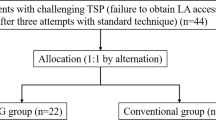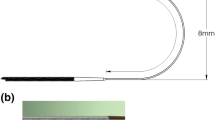Abstract
Background
This study aimed to evaluate the feasibility and safety of an innovative “all in one” integrated transseptal crossing device to achieve transseptal puncture (TSP).
Methods
Twenty patients (10 males, mean age 65.65 ± 9.25 years), indicated to supraventricular left side tachyarrhythmia ablation, underwent TSP using a new-generation integrated crossing device, and a control cohort of twenty patients (10 males, mean age 65.5 ± 10.12 years) underwent TSP using the traditional TSP system.
Results
In all the study patients, the novel TSP device led to a successful and safe access to the left atrium (LA). The mean transseptal time, defined as the time occurring between the groin puncture and the advancing of the guidewire into the left superior pulmonary vein (PV), was 3 min 33 s ± 44 s, 7 min 5 s ± 36 s in the control cohort. Additionally, we compared the cost of the two systems. No acute complications related to the TSP were noted in both cohorts.
Conclusions
TSP performed with the new integrated transseptal system is feasible and safe.




Similar content being viewed by others
References
Cope C. Technique for trans-septal catheterization of the left atrium: preliminary report. J Thorac Surg. 1959;37:482–6.
Ross J, Braunwald E, Morrow AG. Trans-septal left atrial puncture: new technique for the measurement of left atrial pressure in man. Am J Cardiol. 1959;3:653–5.
Gonzalez MD, Otomo K, Shah N, Arruda MS, Beckman KJ, Lazzara R, et al. Transseptal left heart catheterization for cardiac ablation procedures. J Interv Card Electrophysiol. 2001;5:89–95.
Fagundes RL, Mantica M, De Luca L, Forleo G, Pappalardo A, Avella A, et al. Safety of single transseptal puncture for ablation of atrial fibrillation: retrospective study from a large cohort of patients. J Cardiovasc Electrophysiol. 2007;18:1277–81.
Subinas A, Montero V, Ormaetxe J, Martinez-Alday J, Arcocha M, Aguirre J. Transseptal catheterization using electrophysiological landmarks in ablation procedures. Rev Esp Cardiol. 2007;60:80–3.
Silvestry FE, Cohen MS, Armsby LB, Burkule NJ, Fleishman CE, Hijazi ZM, Lang RM, Rome JJ, Wang Y. American Society of Echocardiography; Society for Cardiac Angiography and Interventions. Guidelines for the echocardiographic assessment of atrial septal defect and patent foramen ovale: from the American Society of Echocardiography and Society for Cardiac Angiography and Interventions. J Am Soc Echocardiogr. 2015;28(8):910–58. https://doi.org/10.1016/j.echo.2015.05.015.
De Ponti R, Zardini M, Storti C, Longobardi M, Salerno-Uriarte JA. Transseptal catheterization for radiofrequency catheter ablation of cardiac arrhythmias: results and safety of a simplified method. Eur Heart J. 1998;19:943–50.
Roelke M, Smith AJ, Palacios IF. The technique and safety of transseptal left heart catheterization: the Massachusetts General Hospital experience with 1279 procedures. Cathet Cardiovasc Diagn. 1994;32:332–9.
Lesh MD, Coggins DL, Ports TA. Coronary air embolism complicating transseptal radiofrequency ablation of left free-wall accessory pathways. Pacing Clin Electrophysiol. 1992;15(8):1105–8. https://doi.org/10.1111/j.1540-8159.1992.tb03111.x.
Shariff N, Antha N, Roy M, Joshi H, Levin V. Cerebral embolization during AF ablation—pathophysiology, prevention and management. J Atrial Fibrillation. 2013;5(6):843. https://doi.org/10.4022/jafib.843.
Ströker E, De Greef Y, Schwagten B, Kupics K, Coutiño HE, Takarada K, Abugattas JP, Salghetti F, De Cocker J, Stockman D, Sieira J, Brugada P, Chierchia GB, de Asmundis C. Over-the-needle trans-septal access using the cryoballoon delivery sheath and dilator in atrial fibrillation ablation. Pacing Clin Electrophysiol. 2019;42(7):868–73. https://doi.org/10.1111/pace.13709.
Spragg D, Dalal D, Cheema A, Scherr D, Chilukuri K, Cheng A, et al. Complications of catheter ablation for atrial fibrillation: incidence and predictors. J Cardiovasc Electrophysiol. 2008;19:627–31.
Dagres N, Gerhard H, Kottkamp H, Sommer P, Gaspar T, Bode K, et al. Complications of atrial fibrillation ablation in a high-volume center in 1000 procedures: still cause for concern? J Cardiovasc Electrophysiol. 2009;20:1014–9.
Fromentin S, Sarrazin JF, Champagne J, Nault I, Philippon F, Molin F, Blier L, O’Hara G. Prospective comparison between conventional transseptal puncture and transseptal needle puncture with radiofrequency energy. J Interv Card Electrophysiol. 2011;31(3):237–42. https://doi.org/10.1007/s10840-011-9564-2.
Capulzini L, Paparella G, Sorgente A, de Asmundis C, Chierchia GB, Sarkozy A, Muller-Burri A, Yazaki Y, Roos M, Brugada P. Feasibility, safety, and outcome of a challenging transseptal puncture facilitated by radiofrequency energy delivery: a prospective single-centre study. Europace. 2010;12(5):662–7. https://doi.org/10.1093/europace/euq019.
Author information
Authors and Affiliations
Corresponding author
Ethics declarations
Ethics approval and consent to participate
All patients signed an informed consent that have been approved by our institutional review board. The study complied with the Declaration of Helsinki as reviewed in 2013. The ethic committee approved the study.
Conflict of interest
Carlo de Asmundis receives research grants on behalf of the center from Biotronik, Medtronic, Abbott, LivaNova, Boston Scientific, AtriCure, Philips and Acutus; he received compensation for teaching purposes and proctoring from Medtronic, Abbott, Biotronik, Livanova, Boston Scientific, Atricure and Daiichi Sankyo. Gian B. Chierchia has received compensation for teaching purposes and proctoring from AF Solutions, Medtronic and Biotronik, teaching and speaker fees for Acutus Medical. V. Miraglia has received an educational grant from “Foundation Enrico and Enrica Sovena.” Other authors: no disclosures.
Additional information
Publisher's note
Springer Nature remains neutral with regard to jurisdictional claims in published maps and institutional affiliations.
Rights and permissions
Springer Nature or its licensor holds exclusive rights to this article under a publishing agreement with the author(s) or other rightsholder(s); author self-archiving of the accepted manuscript version of this article is solely governed by the terms of such publishing agreement and applicable law.
About this article
Cite this article
Rizzi, S., Pannone, L., Monaco, C. et al. First experience with a transseptal puncture using a novel transseptal crossing device with integrated dilator and needle. J Interv Card Electrophysiol 65, 731–737 (2022). https://doi.org/10.1007/s10840-022-01329-3
Received:
Accepted:
Published:
Issue Date:
DOI: https://doi.org/10.1007/s10840-022-01329-3




